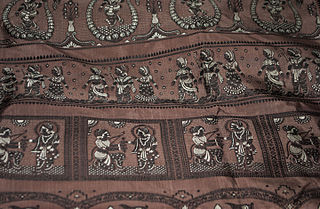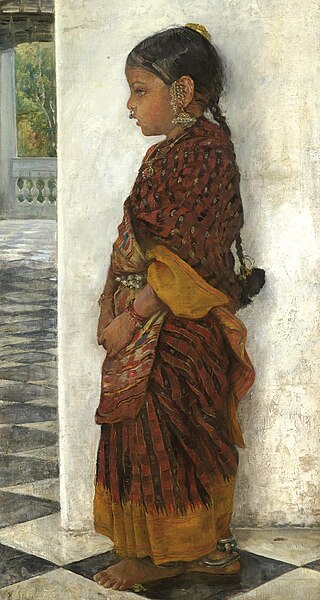A sari (sometimes also saree or shari is a women's garment from South Asia, that consists of an un-stitched stretch of woven fabric arranged over the body as a robe, with one end attached to the waist, while the other end rests over one shoulder as a stole, sometimes baring a part of the midriff. It may vary from 4.1 to 8.2 metres in length, and 60 to 120 centimetres in breadth, and is form of ethnic wear in Nepal, Bangladesh, Pakistan, Sri Lanka, and India. There are various names and styles of sari manufacture and draping, the most common being the Nivi style. The sari is worn with a fitted bodice also called a choli and a petticoat called ghagra, parkar, or ul-pavadai. It remains fashionable in the Indian Subcontinent today.

Jamdani is a fine muslin textile produced for centuries in South Rupshi of Narayanganj district in Bangladesh on the bank of Shitalakhwa river.

A Banarasi sari is a sari made in Varanasi, an ancient city which is also called Benares (Banaras). The saris are among the finest saris in India and are known for their gold and silver brocade or zari, fine silk and opulent embroidery. The saris are made of finely woven silk and are decorated with intricate designs, and, because of these engravings, are relatively heavy.

Kerala sari (Set-sari) is a clothing of women in the Indian state of Kerala.

A Sambalpuri sari is a traditional handwoven bandha (ikat) sari wherein the warp and the weft are tie-dyed before weaving. It is produced in the Sambalpur, Balangir, Bargarh, Boudh and Sonepur districts of Odisha, India. The sari is a traditional female garment in the Indian subcontinent consisting of a strip of unstitched cloth ranging from four to nine metres in length that is draped over the body in various styles.

The Kanchipuram silk sari is a type of silk sari made in the Kanchipuram region in Tamil Nadu, India. These saris are worn as bridal & special occasion saris by most women in Tamil Nadu, Kerala, Karnataka & Andhra Pradesh. It has been recognized as a Geographical indication by the Government of India in 2005–2006.
Kuthampully Saree is a type of Sari traditionally made by weavers from Kuthampully village in Thiruvilwamala Grama Panchayat of Thrissur district of Kerala state in India. The Kuthampully Saree is distinguished by its Saree borders.

Baluchari Sari is a type of sari, a garment worn by women in Bangladesh and Indian states of West Bengal, Tripura and Assam. This particular type of sari originated in West Bengal and is known for depictions of mythological scenes on the anchal of the sari. It used to be produced in Murshidabad but presently Bishnupur and its surrounding areas of West Bengal are the only place where authentic Baluchari saris are produced. It takes approximately one week to produce one such sari. In 2011, the Baluchari Sari was granted the status of Geographical Indication for West Bengal in India.

Silk weaving is a manufacturing industry in Varanasi. Varanasi is known throughout India for its production of very fine silk and Banarasi saris.

Tant sari is a traditional Bengali sari, originating from the Bengal region in the eastern part and usually used by Bengali women. Tant sari are woven from cotton threads and distinguished by its lightness and transparency. It is considered to be the most comfortable sari for the hot and humid climate in the Indian subcontinent.

Chanderi sari is a traditional sari made in Chanderi, Madhya Pradesh, India.
Uppada Jamdani Sari is a silk sari style woven in Uppada of East Godavari district in the Indian state of Andhra Pradesh. It was registered as one of the geographical indication from Andhra Pradesh by Geographical Indications of Goods Act, 1999. Uppada Jamdani saris are known for their light weight.

Pochampally sari or Pochampalli ikat is a saree made in Bhoodan Pochampally, Yadadri Bhuvanagiri district, Telangana State, India. They have traditional geometric patterns in "Paagadu Bandhu" (Ikat) style of dyeing. The intricate geometric designs find their way into sarees and dress materials. The Indian government's official airplane company, Air India, has its cabin crew wear specially designed Pochampally silk sarees.
Venkatagiri Sari is a sari style woven in Venkatagiri of Tirupati district in the Indian state of Andhra Pradesh. It was registered as one of the geographical indication from Andhra Pradesh by Geographical Indications of Goods Act, 1999. Venkatagiri saris are known for their fine weaving. These style of saris can also be found in the villages of Sengunthapuram, Variyankaval, Elaiyur, Kallathur, Andimadam and Marudhur villages.
Kovai Cora cotton or Kovai Kora cotton is a type of saree made in the Coimbatore region in Tamil Nadu, India. It has been recognized as a Geographical indication by the Government of India in 2014–15. The Devanga community are pioneers in weaving Kovai Kora cotton saris. 82 Weaver cooperative Societies in Coimbatore, Tiruppur and Erode are authorised to sell Kovai Kora cotton saris.

Handloom saris are a traditional textile art of Bangladesh and India. The production of handloom saris are important for economic development in rural India.
Mangalagiri Sarees and Fabrics are produced by performing handicraft weaving in Mangalagiri, a town in Guntur district of the Indian state of Andhra Pradesh. It was registered as one of the handicraft in the geographical indication from Andhra Pradesh by Geographical Indications of Goods Act, 1999. The Mangalagiri fabric is produced by weaving with the help of pitlooms from combed yarn by warp and woof interlacing. The fabric then undergoes the process of dyeing. The Nizam design is another characteristic of the fabric.

Habaspuri is a cotton-based traditional handloom textiles of Odisha, India. Habaspuri sari is a major product of this textile. The Bhulia weavers of Chicheguda, Kalahandi district, Odisha are originally attributed for weaving of the Habaspuri fabric. For its uniqueness in weaving, design and production, it has been identified as one of the 14 Geographical Indications of Odisha.

Chendamangalam Saree is a traditional hand woven cotton sari from Chendamangalam, Ernakulam district of Kerala. This saree is part of the Chendamangalam Handloom tradition of Kerala.

Shantipuri sari is a traditional handwoven cotton sari of West Bengal. It is produced in the Shantipur city and surrounding area of Nadia district, West Bengal. Shantipuri handloom sari is famous for the novelty of designs, hand spinning method with extra weft, different color patterns and the thin finesse of the fabric. The fine Shantipuri sari is a highly demanded commodity all over the world. Shantipuri Sari got geographical indications tag in 2009.














